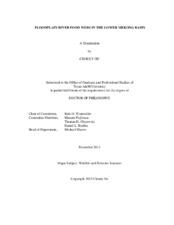| dc.contributor.advisor | Winemiller, Kirk O | |
| dc.creator | Ou, Chouly | |
| dc.date.accessioned | 2014-05-13T17:23:08Z | |
| dc.date.available | 2015-12-01T06:31:21Z | |
| dc.date.created | 2013-12 | |
| dc.date.issued | 2013-11-15 | |
| dc.date.submitted | December 2013 | |
| dc.identifier.uri | https://hdl.handle.net/1969.1/151776 | |
| dc.description.abstract | The Mekong River is one of the world’s most important rivers in terms of its size, economic importance, cultural significance, productivity, and biodiversity. The Mekong River’s fisheries and biodiversity are threatened by major hydropower development and over-exploitation. Knowledge of river food web ecology is essential for management of the impacts created by anthropogenic activities on plant and animal populations and ecosystems. In the present study, I surveyed four tropical rivers in Cambodia within the Mekong River Basin. I examined the basal production sources supporting fish biomass in the four rivers during the dry and wet seasons and explored the relationship between trophic position and body size of fish at various taxonomic levels, among local species assemblages, and across trophic guilds. I used stable isotopes of carbon and nitrogen to estimate fish trophic levels and the principal primary production sources supporting fishes. My study provides evidence that food web dynamics in tropical rivers undergo significant seasonal shifts and emphasizes that river food webs are altered by dams and flow regulation. Seston and benthic algae were the most important production sources supporting fish biomass during the dry season, and riparian macrophytes appeared to be the most important production source supporting fishes during the wet season. In the river with strong flow regulation from an upstream impoundment, seston and benthic algae were even more important production sources supporting fishes during the dry season. My findings challenge the Eltonian theory of size-based trophic structure in food webs and also contradict the broadly accepted prediction of the fishing-down-the-food-web concept. Eltonian and fishing-down-the-food-web concepts propose that trophic level is strongly correlated with body size, but I found no significant correlation between body size and trophic position for fish assemblages. Results suggest that body size distributions are not useful for prediction the trophic structure of communities with diverse detritivores, omnivores and insectivores, but that it is a good predictor of trophic position among piscivorous fishes. | en |
| dc.format.mimetype | application/pdf | |
| dc.language.iso | en | |
| dc.subject | Primary production sources | en |
| dc.subject | trophic position | en |
| dc.subject | stable isotopes | en |
| dc.subject | fisheries | en |
| dc.title | Floodplain River Foodwebs in the Lower Mekong Basin | en |
| dc.type | Thesis | en |
| thesis.degree.department | Wildlife and Fisheries Sciences | en |
| thesis.degree.discipline | Wildlife and Fisheries Sciences | en |
| thesis.degree.grantor | Texas A & M University | en |
| thesis.degree.name | Doctor of Philosophy | en |
| thesis.degree.level | Doctoral | en |
| dc.contributor.committeeMember | Fujiwara, Masami | |
| dc.contributor.committeeMember | Olszewski, Thomas D | |
| dc.contributor.committeeMember | Roelke, Daniel L | |
| dc.type.material | text | en |
| dc.date.updated | 2014-05-13T17:23:08Z | |
| local.embargo.terms | 2015-12-01 | |


